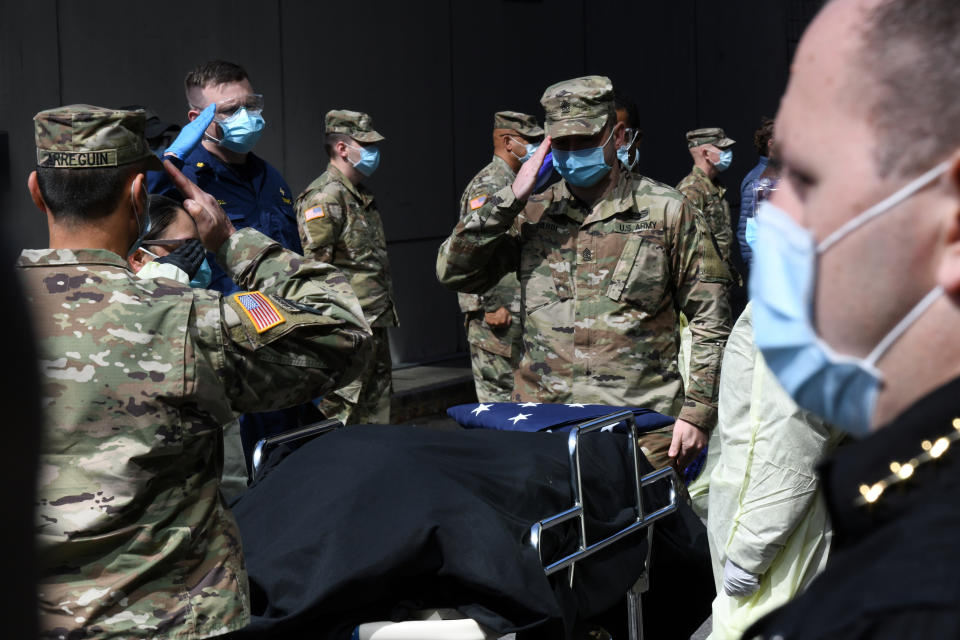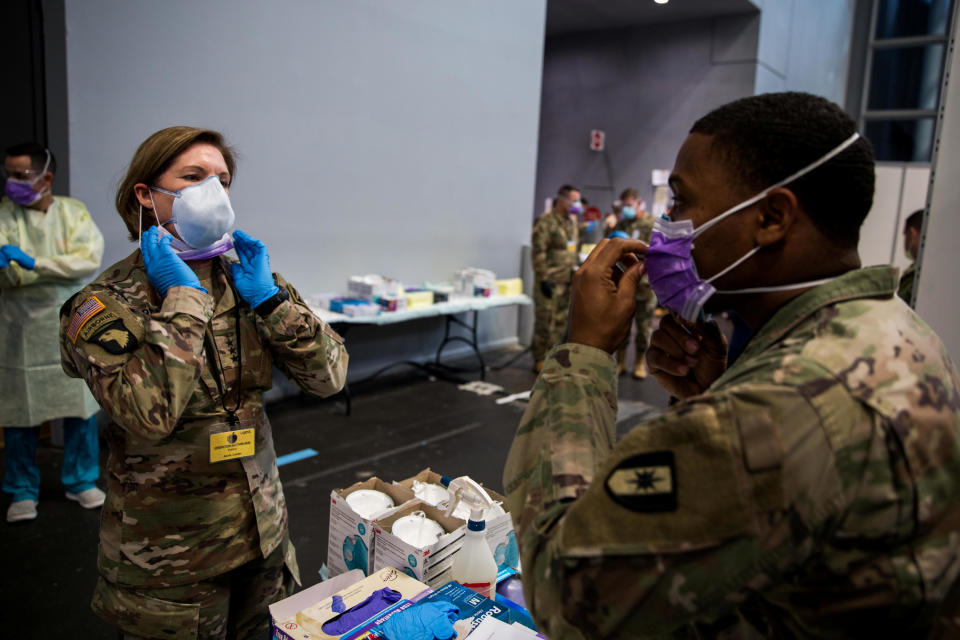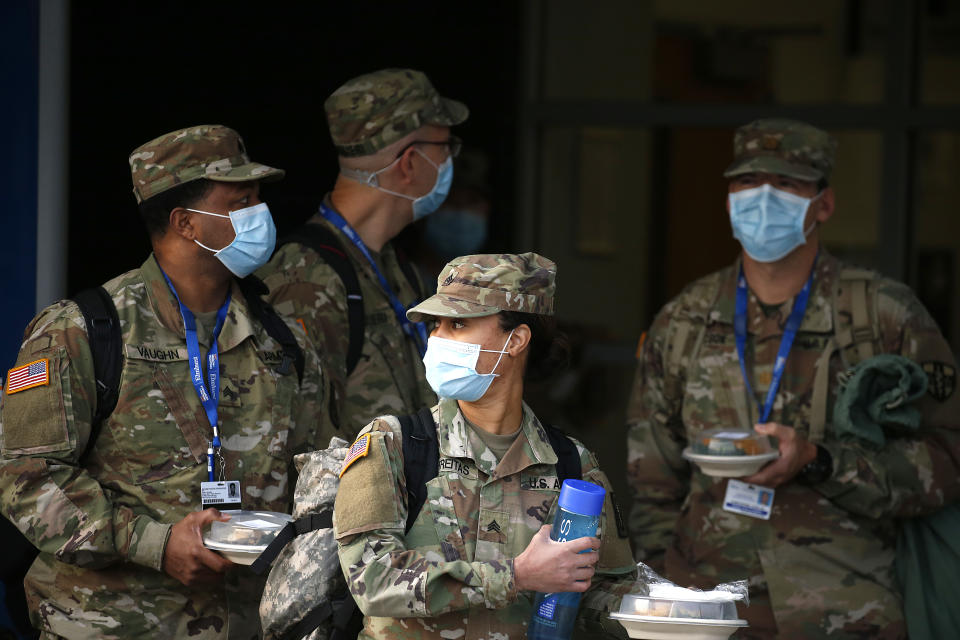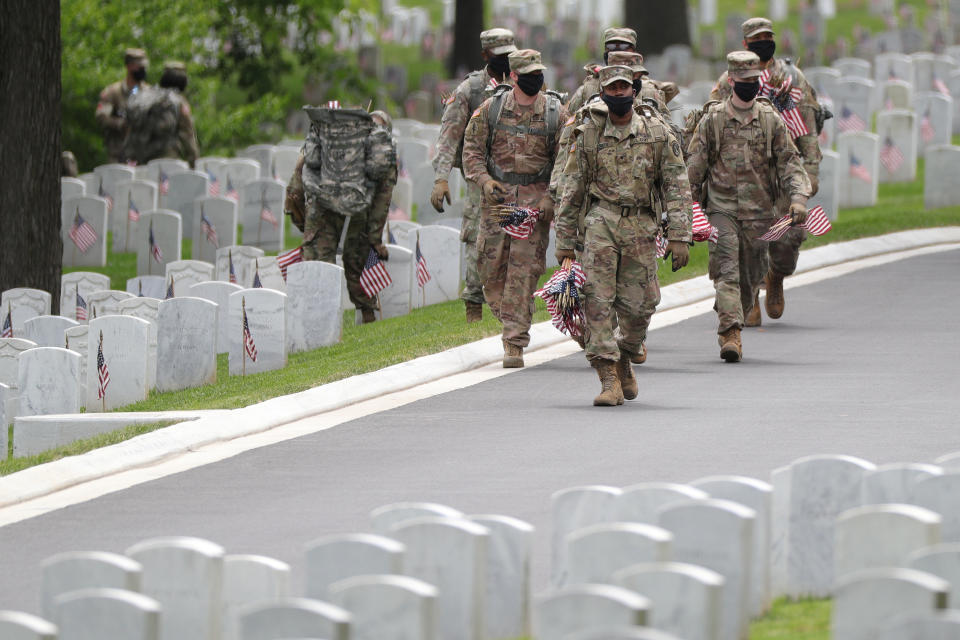As COVID-19 sweeps across the South, the Army finds it’s not immune
WASHINGTON — The U.S. Army is facing a significant COVID-19 challenge as infection rates soar across the South and Southeast, where most of the service’s installations are located. And now the disease is having a major impact on the Army’s second-largest installation, according to a briefing obtained by Yahoo News.
The briefing, dated July 20 and prepared for senior leaders at Fort Campbell, Ky., home to the 101st Airborne Division, shows that on that day, about one in five soldiers — almost a thousand troops in total — in one of the division’s three infantry brigades combat teams were unavailable for training, either because they had tested positive for COVID-19 or because they had been in contact with someone who might have had the disease.
“There has been an impact” on the Army from the coronavirus’s surge across the parts of the country where most soldiers are located, Army Surgeon General Lt. Gen. Scott Dingle told an online Association of the U.S. Army audience Wednesday. “We are also experiencing the same things [as surrounding communities], but not in extremely large numbers.”

As of July 31, there were 9,276 active-duty Army personnel with COVID-19 (an increase of almost 400 in 48 hours). However, because the Defense Department forbids the Army from publicizing the number of cases in any individual unit or installation, it is almost impossible to judge how the service is handling this summer’s steep rise in cases in states like Texas and North Carolina, home to the Army’s two other most populous posts.
Lt. Col. Charles Barrett, a spokesman for the 101st, which has almost 20,000 soldiers and is one of the Army’s most storied formations, said the division is seeing “a slow, steady increase” in cases, but was faring better than the communities around Fort Campbell.
The rise in cases at Fort Campbell, which is occurring as the 101st’s first and second brigades prepare for major training events, has prompted a series of social media posts from soldiers accusing the division of not doing enough to protect soldiers from COVID-19, the disease caused by the coronavirus. In an interview with Yahoo News, the 101st’s commander, Maj. Gen. Brian Winski, disputed the accusations, which appeared on TerminalCWO, a Facebook account that gives voice to soldiers with grievances and is run by an anonymous active-duty Army warrant officer.
Noting that “we have yet to have a single soldier that required hospitalization for COVID,” Winski said he was “really confident” that the division was complying with all guidance from his higher headquarters at XVIII Airborne Corps, U.S. Army Forces Command and the Department of the Army in the Pentagon, as well as with the “parameters” for treatment set forth by the Centers for Disease Control and Prevention.
But messages posted on the TerminalCWO Facebook page said some commanders in the 101st were reluctant to allow soldiers to get tested because they didn’t want to lose large numbers to quarantine during important training exercises. “Everyone keeps getting sick or coming in contact with COVID and then being told by commands not to get tested in fear of losing personnel to quarantine,” said one poster.
Winski said that such guidance is not division policy, but vowed to investigate it. “For the folks reaching out to you and others, that’s what they’re hearing, and we need to address that,” he said, adding that he tended to believe that “where there’s smoke, there’s fire.”
Anyone experiencing COVID-19 symptoms is supposed to inform their chain of command and quarantine immediately, according to Winski. “If they had known contact with somebody that we now know is positive, that would warrant a test,” he said. “If they’re just symptomatic, we keep them in quarantine and see if the symptoms persist, and if so, then it would warrant a test. Or if not, then we would just keep them in symptomatic or asymptomatic quarantine for the 14 days, so if they were to have it, it would run its course.”

A soldier who tests positive for COVID-19 is placed in isolation. The 101st also uses a sort of precautionary quarantine called judicious preventative measures, or JPM, for soldiers who have vague symptoms or who might have come into contact with someone with the disease. Leaders use their own judgement as to whether to place a soldier in JPM, which typically means staying home for no more than a couple of days, at which point they decide whether the soldier needs to move to quarantine until they can get tested or be cleared to go back to work, according to Barrett.
Other social media posts claimed that the division was not planning to test every soldier prior to a large off-site training exercise. That claim is incorrect and is likely a misunderstanding, according to division officials, who said 100 percent of the soldiers slated to deploy on the training rotation are being tested, but in batches of 10.
Winski, the division commander, attributed many of the complaints to “misunderstanding,” but acknowledged that there might be a kernel of truth to some of them. “Anytime there’s a groundswell of concern, there’s probably something to it,” he said.
But taken together, the Facebook posts illustrate what Barrett said is a level of anxiety among soldiers and their families over the pandemic that is even greater than that typically associated with upcoming combat deployments. “COVID has generated a lot of uncertainty and a lot of fear,” he said.
Some of the 101st’s challenges in this regard typify those faced by the military at large, including how to balance the need to stay combat ready with the need to protect troops and their families, and how to keep installations virus-free in regions where COVID-19 is surging and local authorities are less observant than the military of public health advice.
The stress in the 101st over COVID-19 is heightened by the fact that two of the division’s three infantry brigade combat teams (multi-battalion formations of up to 5,000 soldiers each) are slated to go to the Army’s premier light infantry training site at Fort Polk, La., during the next two months. The division’s 2nd Brigade Combat Team is due to start its monthlong rotation next week, followed by the 1st Brigade Combat Team in September.
With most Army units no longer deploying regularly to combat zones, a training center rotation is often the most critical event in a company, battalion or brigade commander’s one- to two-year command tour, and is preceded by many weeks of field training at the brigade combat team’s home post.

But the Army’s quarantine policies mean that one soldier coming down with COVID-19-like symptoms, let alone a confirmed case of the disease, can have a knock-on effect that takes not only that soldier out of action but numerous others for up to 14 days. Interviewed by Yahoo News, a junior enlisted soldier said that one “false positive” in the 101st’s 1st Brigade Combat Team resulted in “pretty much half the company” — or about 60 soldiers — being restricted to quarters.
Those policies are making some commanders reluctant to allow their soldiers to be tested, for fear of losing significant chunks of their formations to quarantine during field training that takes place prior to the rotation at Fork Polk, according to several messages posted on TerminalCWO’s Facebook page. One 2nd BCT soldier wrote that his unit was told “you can’t directly go see medical personnel if you feel symptoms of COVID-19 because you’ll be quarantined instantly and we can’t afford to lose people.”
The junior enlisted soldier in the 1st BCT said that commanders were focused on getting as many soldiers as possible into the field for training. “They wanted the numbers out there more than anything else,” he said. “They weren’t so much worried about the soldiers’ health.”
However, he said that his chain of command was not pressuring soldiers to not seek medical attention if they were feeling sick. “In the brigade, they want you to get tested,” he said.
But a second junior enlisted 1st BCT soldier, when asked whether some commanders were reluctant to allow soldiers to get tested for COVID-19, said “it appears that way,” adding that during a recent training exercise, his chain of command waited several days before sending soldiers who had taken ill in the field back to the garrison.
Winski acknowledged that the division places a high priority on each training rotation at Fort Polk. “We want every soldier that’s absolutely available to be part of that, because it is such a crucible training event and such an excellent replicated environment [with] a dedicated opposing force, dedicated role players who portray civilians on the battlefield and host nation security forces.” However, he said, the division will ensure that no soldiers with COVID-19 deploy to Fort Polk.
It does appear that the field is currently the safest place for troops. According to the slide briefing obtained by Yahoo News, on July 20, the division’s Brigade Combat Team that has been least affected by the virus is its 3rd BCT, most of which has spent the last few months split between operations on the southwest border and East Africa. By contrast, the worst affected formation was 1st BCT, which had 927 soldiers unavailable because of the virus, including 82 troops in isolation and 263 symptomatic soldiers in quarantine.
The numbers appear to confirm Winski’s assertion that most of the division’s COVID-19 cases, based on the research by Fort Campbell’s nine contact trace teams, come from social interactions during off-duty hours, especially in bars and restaurants, not from training or deployments. Fort Campbell straddles the Kentucky-Tennessee border, and is only about 60 miles from the nightlife of Nashville, which has become a COVID-19 “red zone” in recent weeks since reopening.

The increase in cases at Campbell “coincides with the city and county openings” in the surrounding communities, Winski said, adding that the travel conducted by many soldiers and their families over the Fourth of July weekend was also a factor.
But beyond encouraging mask use and social distancing when off-post (and enforcing those activities for soldiers on post), division officials are reluctant to put their troops back on the sort of lockdown that characterized the first months of the pandemic, when all training and movement was canceled. “We cannot return to the shelter-in-place protocols that existed in April of 2020 in which only essential leaders were present for duty,” 1st BCT commander Col. Robert Born said in a video statement posted on his unit’s Facebook page.
Winski acknowledged that the relative youth of an infantry division’s soldiers meant the bright lights of Nashville would always hold an appeal. “It’s just where young folks want to go,” he said.
Indeed, until the latest increase in cases, many soldiers were not taking the pandemic threat seriously, according to an enlisted 1st BCT soldier. “We all poked fun at COVID-19 saying how high the survival rate is,” he said, adding that the attitude of many young troops was “it’s not that big of a deal if you have a good immune system, it really won’t hurt you all that much.”
But in June the brigade’s dining facility was temporarily closed after a soldier who works there tested positive. Then “cases just started popping up randomly, here, there and all over the place,” he said. “I think we’re taking it a little bit more seriously now.”
_____
Read more from Yahoo News:



